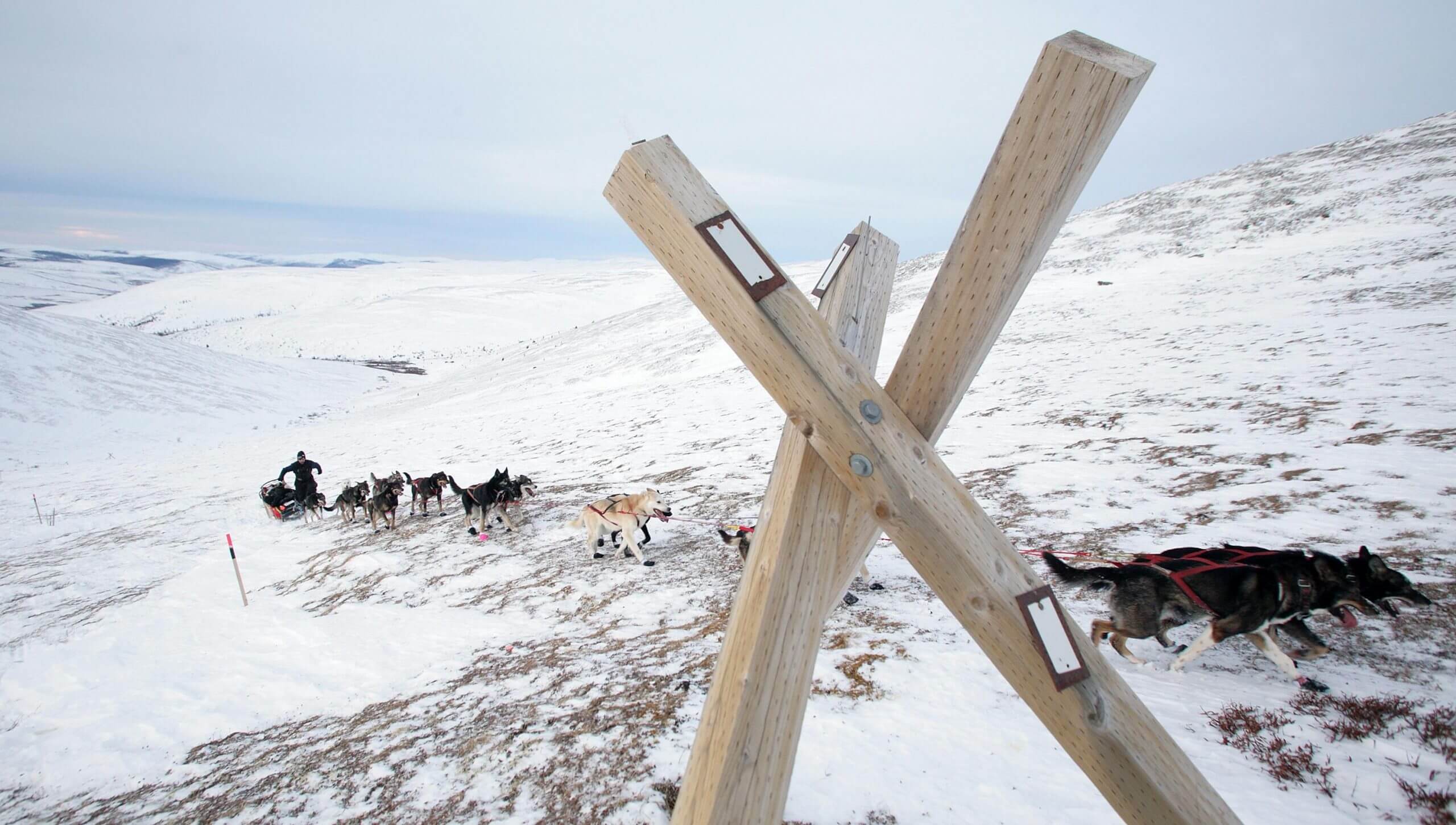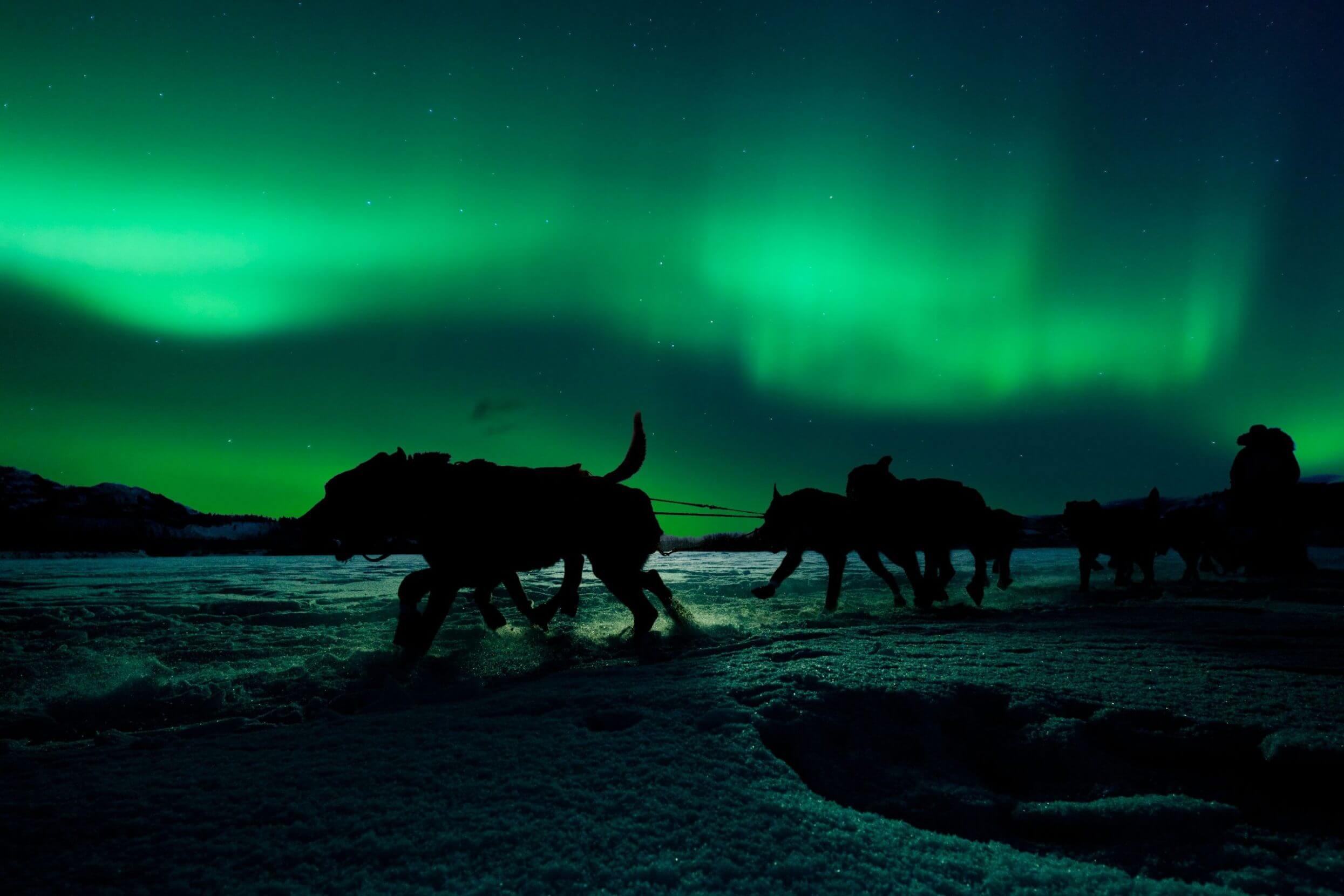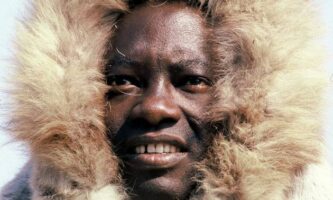Support Hidden Compass
Our articles are crafted by humans (not generative AI). Support Team Human with a contribution!
Michelle Phillips is out in the wild — a team of sled dogs, her only companions. It’s February in Canada’s remote Yukon Territory. Days are short. Nights are long. Both are cold. This time of year, strong winds can make temperatures plummet to -40 degrees Fahrenheit or colder.
Night and day, Phillips has been traversing punishing terrain. From where she began in Whitehorse, there are 1,000 lonely and unforgiving miles to cover and four mountains in her path, including Eagle Point, where blizzards are a distinct possibility. Through icy winds and deep snowdrifts, only the panting of her dogs and the sound of the sled’s runners gliding through the snow penetrate an otherwise hypnotic silence. Except, of course, for when she hears other sounds: The rustle of wind through the leaves of a tree, or, perhaps, a charging bull moose. But the trees are leafless, and the moose isn’t there. Phillips has been out in the wilderness for three days. Exhaustion has sent her mind to strange places.
She is not lost. Nor is she stranded. She is out here by choice, taking part in the Yukon Quest — the most grueling dog sled race on earth. And though it is a race, the emphasis of the Quest is not really on speed. It is on survival.

Musher Lance Mackey of Fairbanks and his dog team climb Eagle Summit — notorious for its blizzards — on Feb. 5, 2012, during the Yukon Quest. Photo: Sam Harrel/Fairbanks Daily News-Miner.
~~
Three days earlier, I’m in Whitehorse — the capital city of the Yukon. I’ve gathered alongside several hundred other people at Shipyards Park to watch the start of the Quest. It’s a clear and cloudless morning in this small city, but the wind chill makes -38 degrees feel like -50. I have journeyed here to the far north to get deep into the minds of people who undertake a sporting event that is as treacherous as it is infamous. I’ve heard that in this competition, losing a digit to frostbite is considered a badge of honor, and I’m fascinated. Why would anyone choose to endure that?
A large crowd has amassed at the park, which lies along the banks of the Yukon River, to watch the start of the race. With frozen eyelashes, they look to the mushers with the reverence of rock star groupies. One fan is wearing a parka with the autographs of all the mushers on the back.
I’ve heard that in this competition, losing a digit to frostbite is considered a badge of honor, and I’m fascinated.
In a nearby holding area, musher trucks are parked in a semi-circle. Every vehicle features a long row of port holes, each with the blue-eyed, grinning face of an Alaskan husky. The mushers are outside, offloading dog sleds from their trucks and packing them with 250-300 pounds of survival equipment and provisions — each dog will consume up to 10,000 calories per day. The Quest could last for two weeks, and checkpoints where they can replenish supplies are few and far between.
Many of the items they carry are mandatory: an axe, snow shoes, straw for the dogs to sleep on, and layers upon layers of clothing. Some wear a layer of plastic beneath their parkas to protect themselves from slush that forms on frozen lakes and rivers when water from below the ice seeps up through the cracks. Out here, getting wet can kill a person quickly.
The mushers let the dogs out of their trucks and start putting harnesses over their heads and shoulders, then attach them to the gang line and to each other in pairs. The dogs yip, their bootie-clad paws coming off the ground as they jump in excitement. Walking around the holding area, I speak to the mushers as they make final preparations. The batteries in my tape recorder freeze within minutes.
Michelle Phillips, small and sturdy, is a Yukoner and thus a local favorite. She’s dressed in full gear with multiple layers beneath her subarctic parka. Fans and journalists surround her, peppering her with questions as she checks her sled and fires up her dogs.
Phillips and the mushers would be living in this cold, and worse, for the next nine to 14 days. The temperatures would be extreme, but so would the danger and the sheer isolation. I ask Phillips why she does it. It’s a question she’s been asked a thousand times.
“It’s a way to travel differently,” she says patiently.
When I ask her what it’s like to be a woman in the sport, her patience wanes. “The only difference is how we pee,”she says curtly. Indeed, sled dog racing is one of the few sports in which men and women compete on equal footing.
That moment aside, Phillips and the others seem relaxed. The dogs, on the other hand, are barking so loud that it’s impossible to hear the emcee’s cheery voice pumping up the crowd, stacked four or five deep along the path to the starting gate.
~~
At 11:00 a.m. PST, the first team leaves the starting gate in a flurry of kicked up snow as the dogs take off. After that, another team leaves every three minutes until all 30 teams are off. The order was randomly selected in a start draw two days ago. Phillips is eighth in line.
The three mountains that ring the town are backlit against the bright sun, reflections glistening like spilled crystals on the snow-covered conifers. Snow crunches under the fans’ feet as they jump up and down at the launch of each sled.

Michelle Phillips and her team of sled dogs burst out of the starting gate on the Chena River in Fairbanks, Alaska at the start of the 2006 Yukon Quest. The starting point of the race alternates between Fairbanks and Whitehorse in the Canadian Yukon. Photo: Patrick Endres/Alaska Stock.
When the last musher leaves, the crowd disperses, but some jump in their cars and head to a bridge on the banks of the Takhini River, the first viewing point to see the mushers in action.
About an hour later, the mushers round the river bend and come into view, whizzing by like apparitions. The dogs are silent now. They’re no longer yipping and jumping. They are focused — running with purpose.
And then, musher and dogs disappear into the wilderness.
~~
The Yukon Quest has a more freewheeling spirt than the better-known Iditarod. It was, after all, dreamed up one night in 1983 by four mushers in Fairbanks’ Bull’s Eye Saloon. LeRoy Shank, Roger Williams, Ron Rosser, and William “Willy” Lipps wanted to create a race that would pay homage to the Klondike Gold Rush routes of the 1890s. But they also wanted a race that would be distinct from the Iditarod in both geography and spirit.
There were too many checkpoints and stages in the Iditarod, they thought. They envisioned a wilder endurance race. And so, the Quest was born, with only nine checkpoints for rest, supply pick up, and defrosting digits (compared to the Iditarod’s 23 checkpoints over a similar distance), and a 210-mile stretch between Pelly Crossing and Dawson City during which mushers might see no other human beings.
For most of us, the Quest would be the very definition of hell frozen over. But for self-described “Quest Addicts,” it’s a way of life.
It’s not just the number of checkpoints that makes the Quest a serious challenge, though. The trail is broken and marked prior to the race, but weather conditions can erase all traces of it. Winds can reach 100 miles per hour. While cold weather can cause frostbite and hypothermia, “warmer” weather (hovering around freezing) provides obstacles too. “Jumble ice” occurs when ice atop flowing rivers fractures and refreezes, creating an irregular surface which can endanger mushers and their team. Given the choice, I’m told, mushers would opt for extreme cold.
For most of us, the Quest would be the very definition of hell frozen over. But for self-described “Quest Addicts,” it’s a way of life. Phillips has been mushing for 22 years. This is her 6th Quest. When asked how it differs from her experience in the Iditarod, she says:
“With the Yukon Quest, you are more alone. You travel long distances by yourself. Your sled is a lot heavier. It’s much darker than the Iditarod… how you test yourself, traveling with a dog team for so many miles, it just really appeals to me.”
~~
Beyond the unforgiving weather, the wild terrain, and the solitude, there is fatigue.
Four hours on, four off is typical for teams. But when mushers do take a break, almost all of the rest period goes to caring for their dogs.
“I put a hook line down. I walk down the line, take booties off, massage each [paw], then get snow and melt it for water,” Phillips says. “When the water’s hot, I cook their food. Then they have a sleep while I repack my sled for the next stretch. Then I eat my dinner and possibly have a rest.”
Out of a four-hour rest period, mushers might get one hour for themselves. If they’re lucky, they’ll get two to three hours of sleep per night.
In some ways, this is as much a competition of who can best fight off exhaustion: “Sometimes mushers are so tired they tie their hands to the sled, in case they fall asleep while they are mushing,” one competitor tells me.
A 2018 review of sleep deprivation studies, published in Frontiers in Psychiatry, revealed that “perceptual distortions, anxiety, irritability, depersonalization, and temporal disorientation started within 24 [to] 48 [hours] of sleep loss.” Disordered thinking and complex hallucinations weren’t far behind. The timeline fits with when Phillips says mushers begin to experience disconnects with reality — and when she begins to hallucinate.
It’s normal to see strange snow creatures or “trees hitting you in the face that are not there,” she says. Some of the things she describes, like “throwing your mitts down for no reason,” aren’t just nonsensical: They’re dangerous.
But the great racers, it seems, find a way to keep on racing. Phillips has learned to power through the fatigue — focusing on her dogs helps — to get to the other side of what she calls “The Wall,” which can send mushers into spirals of self-doubt and second-guessing. But when she gets to the other side, she says, the payoff is unlike anything else.
“It’s that point where you are loving leaving the world behind and just worrying about your dog team and having food to survive, [while] traveling through the night watching the northern lights.” She describes the aurora above dancing to the music on her iPod, and it almost makes me want to be on the trail, too. Like many mushers, Phillips prefers to mush at night by the light of the moon.

A sled dog team pulls their musher and sleigh under the hue of the northern lights. Many mushers, including Phillips, prefer to run their dogs at night by the light of the moon and the aurora borealis. Photo: Stephan Pietzko/Alamy.
~~
Phillips says she can’t imagine sharing the experience with anyone but her dogs, who she refers to as her family. She and her husband, Ed, who introduced her to mushing 22 years ago, have raised each of the huskies pulling her sled since they were puppies. The couple runs Tagish Lake Kennel in the Yukon, home to more than 60 dogs. They live off-grid and care for the dogs by themselves for most of the year.
“We see different things in the animal and that’s important to us,” she tells me.
“These dogs are our best friends, our families,” says Phillips. “I think anyone who has spent any time with working animals knows these dogs have been bred for hundreds of years to do this, and they absolutely love it.”
She seems to anticipate my next question: Is sled dog racing humane?
Some have called for an end to the Quest, the Iditarod, and other dog sled races, even going as far as to produce a movie that purported to reveal the truth about how the dogs are treated. But many in the community believe the movie was misleading and some even threatened legal action.
Phillips and the veterinarians who check Quest dogs require that the dogs are in optimum health before being included on a team. There are mandatory medical checks before, during, and after the race. Any dog that does not qualify for a certificate of good health is prohibited from running. Mushers who violate rules are fined or disqualified.
And while losing a human digit to frostbite might be a badge of honor for the mushers, the dogs’ well-being is not taken as lightly.
“These dogs are our best friends, our families,” says Phillips. “I think a lot of these people [who protest against the race] have lost connection with what life is. I think anyone who has spent any time with working animals knows these dogs have been bred for hundreds of years to do this, and they absolutely love it.”
~~
At the Quest’s close, 27 mushers complete the race. Three have scratched — ending their race before finishing. Those who finish have traveled a distance greater than the length of California.
Michelle Phillips finishes fourth in the 2019 Yukon Quest. She reaches the finish line in Fairbanks, Alaska, at 4:47 p.m. AKST on Feb. 11, tying her best-ever result, which she earned in 2008.
“You definitely feel like you’ve gone 1,000 miles when you finish,” she says.
But officials say Phillips seems clear-headed at the end. After everything she’s been through, she only wants two things: a bath and a beer.
The power struggle between the wild and the woman is over, at least for this year.
Karen Burshtein
Karen Burshtein is an independent writer, editor, and translator who writes about all aspects of Canadian culture and history.



